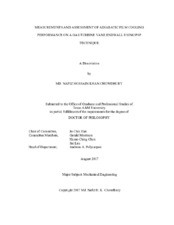| dc.contributor.advisor | Han, Je-Chin | |
| dc.creator | Chowdhury, MD Nafiz Hossain Khan | |
| dc.date.accessioned | 2018-02-05T16:48:20Z | |
| dc.date.available | 2019-08-01T06:52:17Z | |
| dc.date.created | 2017-08 | |
| dc.date.issued | 2017-05-17 | |
| dc.date.submitted | August 2017 | |
| dc.identifier.uri | https://hdl.handle.net/1969.1/165699 | |
| dc.description.abstract | Turbine vanes are typically assembled as a section containing single or double airfoil
units in an annular pattern. First stage guide vane assembly results in two common mating
interfaces - a gap between combustor and vane endwall while another from the adjacent
sections, called slashface. High-pressure coolant could leak through these gaps to reduce
the ingestion of hot gas and achieve certain cooling benefit. As vane endwall region flow
field is already very complicated due to the presence of highly three-dimensional
secondary flows, then a significant influence on endwall cooling can be expected due to
the gap leakage flows. The entire study is divided into two parts. The first part of this
dissertation investigates the endwall film cooling from gap leakage flows with the
multiple rows of discrete film cooling holes inside the passages. The later part studies the
film cooling performance of multiple endwall cooling designs including inlet leakage jet.
Pressure Sensitive Paint (PSP) technique is used to obtain the detailed film cooling
effectiveness distributions on the endwall of a scaled up mid-range industrial turbine vane
geometry. Experiments are performed in a blow-down wind tunnel cascade facility at the
isentropic exit Mach number of 0.5 corresponding to Reynolds number of 3.8 x 105 based
on inlet conditions and axial chord length. Passive turbulence grid is used to generate
freestream turbulence level about 19% with an integral length scale of 1.7 cm. The effect
of coolant-to-mainstream mass flow ratio and density ratio on the film cooling have been
studied. Results indicated that leakage coolants have significant influence on the endwall
film cooling and different endwall cooling designs are capable of achieving higher cooling
effectiveness with relatively uniform coverage | en |
| dc.format.mimetype | application/pdf | |
| dc.language.iso | en | |
| dc.subject | Endwall | en |
| dc.subject | Mass Flow Ratio | en |
| dc.subject | Density Ratio | en |
| dc.subject | Film Cooling Effectiveness | en |
| dc.subject | PSP Technique | en |
| dc.title | Measurements and Assessment of Adiabatic Film Cooling Performance on a Gas Turbine Vane Endwall Using PSP Technique | en |
| dc.type | Thesis | en |
| thesis.degree.department | Mechanical Engineering | en |
| thesis.degree.discipline | Mechanical Engineering | en |
| thesis.degree.grantor | Texas A & M University | en |
| thesis.degree.name | Doctor of Philosophy | en |
| thesis.degree.level | Doctoral | en |
| dc.contributor.committeeMember | Morrison, Gerald | |
| dc.contributor.committeeMember | Chen, Hamn-Ching | |
| dc.contributor.committeeMember | Lau, Sai | |
| dc.type.material | text | en |
| dc.date.updated | 2018-02-05T16:48:20Z | |
| local.embargo.terms | 2019-08-01 | |
| local.etdauthor.orcid | 0000-0001-8828-9520 | |


